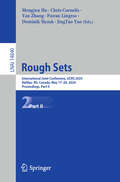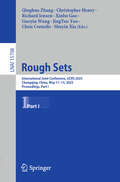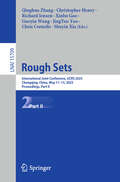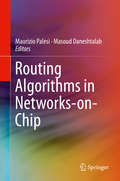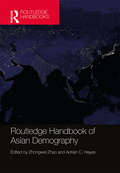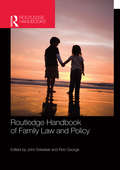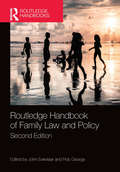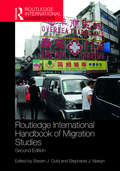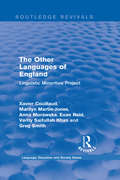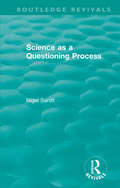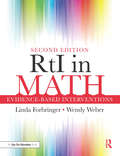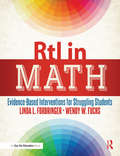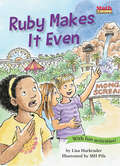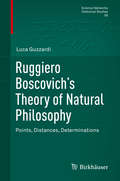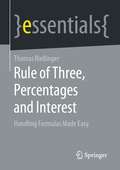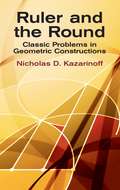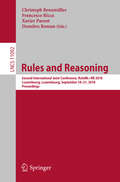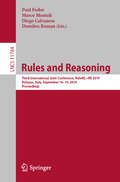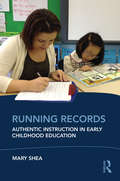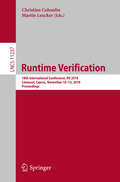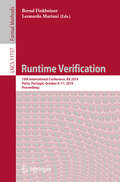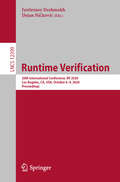- Table View
- List View
Rough Sets: International Joint Conference, IJCRS 2024, Halifax, NS, Canada, May 17–20, 2024, Proceedings, Part II (Lecture Notes in Computer Science #14840)
by Pawan Lingras Dominik Ślęzak Yan Zhang Chris Cornelis JingTao Yao Mengjun HuThis two-volume set LNAI 14839-14840 constitutes the refereed proceedings of the International Joint Conference on Rough Sets, IJCRS 2024, held in Halifax, NS, Canada, during May 17–20, 2024. The 43 full papers included in this book were carefully reviewed and selected from 56 submissions. They are organized in topical sections as follows: Part I: Rough Set Models and Foundations; Rule Induction and Machine Learning; Granular Computing; and Rough Set Applications. part II: Three-Way Decision and Rough Sets; Three-Way Decision in Data Analytics; Three-Way Decision in Broad Senses; Rental Market Data Mining; and Applications of Deep Learning and Soft Computing.
Rough Sets: International Joint Conference, IJCRS 2025, Chongqing, China, May 11–13, 2025, Proceedings, Part I (Lecture Notes in Computer Science #15708)
by Richard Jensen Xinbo Gao Guoyin Wang Chris Cornelis JingTao Yao Shuyin Xia Qinghua Zhang Christopher HenryThis three-volume set LNAI 15708-15709-15110 constitutes the proceedings of the International Joint Conference on Rough Sets, IJCRS 2025, held in Chongqing, China, during May 11–13, 2025.The 90 full papers included in these volumes were carefully reviewed and selected from 187 submissions. They are organized in topical sections as follows:Part I: Rough Set Models and Foundations; Fuzzy Rough Sets and Rough Fuzzy Sets; and Granular Computing.Part II: Rough Set Applications; Feature Selection and Knowledge Discovery; and Cognitive Computing.Part III: Three-way Data Analytics and Decision; Medicine and Health Data Mining; and Applications of Deep Learning and Soft Computing.
Rough Sets: International Joint Conference, IJCRS 2025, Chongqing, China, May 11–13, 2025, Proceedings, Part II (Lecture Notes in Computer Science #15709)
by Richard Jensen Xinbo Gao Guoyin Wang Chris Cornelis JingTao Yao Shuyin Xia Qinghua Zhang Christopher HenryThis three-volume set LNAI 15708-15709-15110 constitutes the proceedings of the International Joint Conference on Rough Sets, IJCRS 2025, held in Chongqing, China, during May 11–13, 2025.The 90 full papers included in these volumes were carefully reviewed and selected from 187 submissions. They are organized in topical sections as follows:Part I: Rough Set Models and Foundations; Fuzzy Rough Sets and Rough Fuzzy Sets; and Granular Computing.Part II: Rough Set Applications; Feature Selection and Knowledge Discovery; and Cognitive Computing.Part III: Three-way Data Analytics and Decision; Medicine and Health Data Mining; and Applications of Deep Learning and Soft Computing.
Rough Sets: International Joint Conference, IJCRS 2025, Chongqing, China, May 11–13, 2025, Proceedings, Part III (Lecture Notes in Computer Science #15710)
by Richard Jensen Xinbo Gao Guoyin Wang Chris Cornelis JingTao Yao Shuyin Xia Qinghua Zhang Christopher HenryThis three-volume set LNAI 15708-15709-15110 constitutes the proceedings of the International Joint Conference on Rough Sets, IJCRS 2025, held in Chongqing, China, during May 11–13, 2025.The 90 full papers included in these volumes were carefully reviewed and selected from 187 submissions. They are organized in topical sections as follows:Part I: Rough Set Models and Foundations; Fuzzy Rough Sets and Rough Fuzzy Sets; and Granular Computing.Part II: Rough Set Applications; Feature Selection and Knowledge Discovery; and Cognitive Computing.Part III: Three-way Data Analytics and Decision; Medicine and Health Data Mining; and Applications of Deep Learning and Soft Computing.
Round Up: A Texas Counting Book
by Carol CraneVarious objects, animals, and people associated with the state of Texas are presented in short rhymes, with added commentary, and used to illustrate counting, multiplying, and adding.
Routing Algorithms in Networks-on-Chip
by Maurizio Palesi Masoud DaneshtalabThis book provides a single-source reference to routing algorithms for Networks-on-Chip (NoCs), as well as in-depth discussions of advanced solutions applied to current and next generation, many core NoC-based Systems-on-Chip (SoCs). After a basic introduction to the NoC design paradigm and architectures, routing algorithms for NoC architectures are presented and discussed at all abstraction levels, from the algorithmic level to actual implementation Coverage emphasizes the role played by the routing algorithm and is organized around key problems affecting current and next generation, many-core SoCs. A selection of routing algorithms is included, specifically designed to address key issues faced by designers in the ultra-deep sub-micron (UDSM) era, including performance improvement, power, energy, and thermal issues, fault tolerance and reliability.
Routledge Handbook of Asian Demography
by Zhongwei Zhao Adrian C. HayesHome to close to 60 per cent of the world’s population, Asia is the largest and by far the most populous continent. It is also extremely diverse, physically and culturally. Asian countries and regions have their own distinctive histories, cultural traditions, religious beliefs and political systems, and they have often pursued different routes to development. Asian populations also present a striking array of demographic characteristics and stages of demographic transition. This handbook is the first to provide a comprehensive study of population change across the whole of Asia. Comprising 28 chapters by more than 40 international experts this handbook examines demographic transitions on the continent, their considerable variations, their causes and consequences, and their relationships with a wide range of social, economic, political and cultural processes. Major topics covered include: population studies and sources of demographic data; historical demography; family planning and fertility decline; sex preferences; mortality changes; causes of death; HIV/AIDS; population distribution and migration; urbanization; marriage and family; human capital and labour force; population ageing; demographic dividends; political demography; population and environment; and Asia’s demographic future. This handbook provides an authoritative and comprehensive reference for researchers, policymakers, academics, students and anyone who is interested in population change in Asia and the world.
Routledge Handbook of Family Law and Policy
by John Eekelaar Rob GeorgeChanges in family structures, demographics, social attitudes and economic policies over the last sixty years have had a large impact on family lives and correspondingly on family law. This book provides global perspectives on the policy challenges facing family law and policy round the world. The chapters apply legal, sociological, demographic and social work research to explore the most significant issues that have been commanding the attention of family law policy-makers in recent years. Featuring contributions from a range of renowned global experts, the book draws on multiple jurisdictions and offers comparative analysis across a range of countries. The book addresses a range of issues including: the role of the state in supporting families and protecting the vulnerable children’s rights and parental authority sexual orientation and gender in family law the status of marriage and other forms of adult relationships divorce and separation and their consequences the relationship between civil law and the law of minority groups assisted conception movement of family members between jurisdictions This advanced level reference work will be essential reading for students, researchers and scholars of family law and social policy as well as policy makers in the field.
Routledge Handbook of Family Law and Policy, 2nd edition
by John Eekelaar Rob GeorgeChanges in family structures, demographics, social attitudes and economic policies over the last sixty years have had a large impact on family lives and correspondingly on family law. The second edition of this Handbook draws upon recent developments to provide a comprehensive and up-to-date global perspective on the policy challenges facing family law and policy round the world.The chapters apply legal, sociological, demographic and social work research to explore the most significant issues that have been commanding the attention of family law policy-makers in recent years. Featuring contributions from a range of renowned global experts, the book draws on multiple jurisdictions and offers comparative analysis across a range of countries. The book addresses a range of issues including the role of the state in supporting families and protecting the vulnerable, children’s rights and parental authority, sexual orientation, same-sex unions and gender in family law, the status of marriage and other forms of adult relationships. It also focuses on divorce and separation and their consequences, the relationship between civil law and the law of minority groups, refugees, migrants and movement of family members between jurisdictions along with assisted conception, surrogacy and adoption. This advanced level reference work will be essential reading for students, researchers and scholars of family law and social policy as well as policy makers in the field.
Routledge International Handbook of Migration Studies: 2nd edition (Routledge International Handbooks)
by Steven J. Gold Stephanie J. NawynThis revised and expanded second edition of Routledge International Handbook of Migration Studies provides a comprehensive basis for understanding the complexity and patterns of international migration. Despite increased efforts to limit its size and consequences, migration has wide-ranging impacts upon social, environmental, economic, political and cultural life in countries of origin and settlement. Such transformations impact not only those who are migrating, but those who are left behind, as well as those who live in the areas where migrants settle. Featuring forty-six essays written by leading international and multidisciplinary scholars, this new edition showcases evolving research and theorizing around refugees and forced migrants, new migration paths through Central Asia and the Middle East, the condition of statelessness and South to South migration. New chapters also address immigrant labor and entrepreneurship, skilled migration, ethnic succession, contract labor and informal economies. Uniquely among texts in the subject area, the Handbook provides a six-chapter compendium of methodologies for studying international migration and its impacts. Written in a clear and direct style, this Handbook offers a contemporary integrated resource for students and scholars from the perspectives of social science, humanities, journalism and other disciplines.
Routledge Revivals: Linguistic Minorities Project (Routledge Revivals: Language, Education and Society Series #2)
by Greg Smith Xavier Couillaud Marilyn Martin-Jones Anna Morawska Euan Reid Verity Saifullah KhanThe ‘other’ languages of England — those which originate in South and East Asia, and Southern and Eastern Europe — are now important parts of everyday life in urban England. First published in 1985, this book gives detailed information about which languages are in widespread use among children and adults, patterns of language use in different social contexts, the teaching of these community languages inside and outside of mainstream schools, and the educational implications of this linguistic diversity for all children in England. They authors argue that this continued and widespread bilingualism is a valuable potential resource for both the speakers and society as a whole.
Routledge Revivals: Science as a Questioning Process (Routledge Revivals)
by Nigel SanittFirst published in 1996, Science as a Questioning Process evaluates scientific theories through from Darwinian evolution to relativity, and from quantum theory to cosmology. It offers an examination of these theories, in terms of a compromise between resolvable empirical questions, and theoretical questions left unresolved. The book asks questions that deal with both intellectual and public concern about what science tells us, and how reliable it is. Through this novel perspective, the book examines science in the context of everyday culture and the role it plays in everyday life. This book will be of interest to anyone working in the fields of philosophy, sociology and science.
RtI in Math: Evidence-Based Interventions
by Linda Forbringer Wendy WeberLearn how to help K–8 students who struggle in math. Now in its second edition, this book provides a variety of clear, practical strategies that can be implemented right away to boost student achievement. Discover how to design lessons that work with struggling learners, implement math intervention recommendations from the Institute of Education Sciences Practice Guides, the National Center on Intensive Intervention, and CEC, use praise and self-motivation more effectively, develop number sense and computational fluency, teach whole numbers and fractions, increase students’ problem-solving abilities, and more! This edition features an all-new overview of effective instructional practices to support academic engagement and success, ideas for intensifying instruction within tiered interventions, and a detailed set of recommendations aligned to both CCSSM and CEC/CEEDAR’s High-Leverage Practices to help support students struggling to meet grade-level expectations. Extensive, current examples are provided for each strategy, as well as lesson plans, games, and resources.
RtI in Math: Evidence-Based Interventions for Struggling Students
by Wendy Fuchs Linda ForbringerLearn how to help K–8 students who struggle in math. This book provides a variety of clear, practical strategies that can be implemented right away to boost student achievement. You will find out how to design lessons that work with struggling learners, implement the recommendations for math intervention from the What Works Clearinghouse, use praise and self-motivation more effectively, develop number sense and computational fluency, teach whole numbers and fractions, increase students’ problem-solving abilities, and more! Extensive examples are provided for each strategy, as well as lesson plans, games, and resources.
Ruby Makes It Even!: Odd/even Numbers (Math Matters)
by Lisa HarkraderDiscover Math Matters! With over 15 million books sold worldwide, this award-winning series of easy-to-read books will help young readers ages 5–8 approach math with enthusiasm. Great for fans of MathStart or Step into Reading Math. Ruby and her two best friends are excited about going to the amusement park. That is, until they discover that the rides they want to go on have seats for two, not three. Someone will have to ride alone—or will they?With engaging stories that connect math to kids&’ everyday lives, each book in the Teachers&’ Choice Award–winning Math Matters series focuses on a single concept and reinforces math vocabulary and skills. Bonus activities in the back of each book feature math and reading comprehension questions, and even more free activities online add to the fun! (Math topic: Odd/Even Numbers)
Ruggiero Boscovich’s Theory of Natural Philosophy: Points, Distances, Determinations (Science Networks. Historical Studies #60)
by Luca GuzzardiDrawing on published works, correspondence and manuscripts, this book offers the most comprehensive reconstruction of Boscovich’s theory within its historical context. It explains the genesis and theoretical as well as epistemological underpinnings in light of the Jesuit tradition to which Boscovich belonged, and contrasts his ideas with those of Newton, Leibniz, and their legacy. Finally, it debates crucial issues in early-modern physical science such as the concept of force, the particle-like structure of matter, the idea of material points and the notion of continuity, and shares novel insights on Boscovich’s alleged influence on later developments in physics. With its attempt to reduce all natural forces to one single law, Boscovich’s Theory of Natural Philosophy, published in 1758, left a lasting impression on scientists and philosophers of every age regarding the fundamental unity of physical phenomena. The theory argues that every pair of material points is subject to one mutual force — and always the same force — which is their propensity to be mutually attracted or repelled, depending on their distance from one another. Furthermore, the action of this unique force is visualized through a famous diagram that fascinated generations of scientists. But his understanding of key terms of the theory — such as the notion of force involved and the very idea of a material point — is only ostensibly similar to our current conceptual framework. Indeed, it needs to be clarified within the plurality of contexts in which it has emerged rather than being considered in view of later developments.The book is recommended for scholars and students interested in the ideas of the early modern period, especially historians and philosophers of science, mathematicians and physicists with an interest in the history of the discipline, and experts on Jesuit science and philosophy.
Rule of Three, Percentages and Interest: Handling Formulas Made Easy (essentials)
by Thomas RießingerIn this essential, Thomas Rießinger explains the rules of percentage and interest calculation using many examples. The basic terms of interest and percentage calculation and the corresponding formulas are repeated so that they are easy to apply in everyday life. The author applies the percentage calculation to interest rate problems and introduces different types of three-sentence calculation.This book is a translation of the original German 1st edition Dreisatz, Prozente und Zinsen by Thomas Rießinger, published by Springer Fachmedien Wiesbaden GmbH, part of Springer Nature in 2016. The translation was done with the help of artificial intelligence (machine translation by the service DeepL.com). A subsequent human revision was done primarily in terms of content, so that the book will read stylistically differently from a conventional translation. Springer Nature works continuously to further the development of tools for the production of books and on the related technologies to support the authors.
Ruler and the Round: Classic Problems in Geometric Constructions (Dover Books on Mathematics)
by Nicholas D. KazarinoffAlthough easy to comprehend and fun to do, many geometric constructions defy completion with just a ruler and a compass. This book takes an intriguing look at the most famous of these "impossible" constructions. In exploring ground rules, history, and angle trisection, the first part considers angle trisection and bird migration, constructed points, analytic geometry, algebraic classification of constructible numbers, fields of real numbers, cubic equations, and marked ruler, quadratix, and hyperbola (among other subjects). The second part treats nonconstructible regular polygons and the algebra associated with them; specifically, irreducibility and factorization, unique factorization of quadratic integers, finite dimensional vector spaces, algebraic fields, and nonconstructible regular polygons. High school and college students as well as amateur mathematicians will appreciate this stimulating and provocative book, and its glimpses into the crucial role geometry plays in a wide range of mathematical applications.
Rules and Reasoning: Second International Joint Conference, RuleML+RR 2018, Luxembourg, Luxembourg, September 18–21, 2018, Proceedings (Lecture Notes in Computer Science #11092)
by Dumitru Roman Christoph Benzmüller Francesco Ricca Xavier ParentThis book constitutes the proceedings of the International Joint Conference on Rules and Reasoning, RuleML+RR 2018, held in Luxembourg during September 2018. This is the second conference of a new series, joining the efforts of two existing conference series, namely “RuleML” (International Web Rule Symposium) and “RR” (Web Reasoning and Rule Systems).The 10 full research papers presented together with 5 long technical communications and 7 short papers were carefully reviewed and selected from 33 submissions.
Rules and Reasoning: Third International Joint Conference, RuleML+RR 2019, Bolzano, Italy, September 16–19, 2019, Proceedings (Lecture Notes in Computer Science #11784)
by Diego Calvanese Paul Fodor Dumitru Roman Marco MontaliThis book constitutes the proceedings of the International Joint Conference on Rules and Reasoning, RuleML+RR 2019, held in Bolzano, Italy, during September 2019. This is the third conference of a new series, joining the efforts of two existing conference series, namely “RuleML” (International Web Rule Symposium) and “RR” (Web Reasoning and Rule Systems). The 10 full research papers presented together with 5 short technical communications papers were carefully reviewed and selected from 26 submissions.
Running Records: Authentic Instruction in Early Childhood Education
by Mary SheaThe most effective way to understand what a child knows about the reading process is to take a running record. In Running Records, Mary Shea demonstrates how teachers can use this powerful tool to design lessons that decrease reading difficulties, build on strengths, and stimulate motivation, ensuring that children develop self-sustaining learning strategies. Special Features include: a step-by-step outline for taking efficient running records guidance in running record analysis: readers will learn how to use running record data to determine a child’s level of decoding skill, comprehension, fluency, and overall reading confidence a Companion Website offering videos of the running record process, sample running records for analysis, and numerous other resources In order to meet the multi-faceted needs of children in today's classrooms, teachers must be knowledgeable about literacy concepts. Running Records provides that invaluable knowledge, making it an ideal text for literacy courses for pre-service teachers and a key professional reference for in-service teachers.
Running Regressions
by Michelle Baddeley Diana BarrowcloughRunning Regressions introduces first-year social science undergraduates, particularly those studying economics and business, to the practical aspects of simple regression analysis, without adopting an esoteric, mathematical approach. It shows that statistical analysis can be simultaneously straightforward, useful and interesting, and can deal with topical, real-world issues. Each chapter introduces an economic theory or idea by relating it to an issue of topical interest, and explains how data and econometric analysis can be used to test it. The book can be used as a self-standing text or to supplement conventional econometric texts. It is also ideally suited as a guide to essays and project work.
Runtime Verification: 18th International Conference, RV 2018, Limassol, Cyprus, November 10–13, 2018, Proceedings (Lecture Notes in Computer Science #11237)
by Martin Leucker Christian ColomboThis book constitutes the refereed proceedings of the 18th International Conference on Runtime Verification, RV 2018, held in Limassol, Cyprus, in November 2018. The 21 full papers presented together with 3 short papers and 3 tool papers were carefully reviewed and selected from 49 submissions. The RV conference is concerned with all aspects of monitoring and analysis of hardware, software and more general system executions. Runtime verification techniques are lightweight techniques to assess correctness, reliability, and robustness; these techniques are significantly more powerful and versatile than conventional testing, and more practical than exhaustive formal verification.Chapter “Hardware-based Runtime Verification with Embedded Tracing Units and Stream Processing” is available open access under a Creative Commons Attribution 4.0 International License via link.springer.com.
Runtime Verification: 19th International Conference, RV 2019, Porto, Portugal, October 8–11, 2019, Proceedings (Lecture Notes in Computer Science #11757)
by Leonardo Mariani Bernd FinkbeinerThis book constitutes the refereed proceedings of the 19th International Conference on Runtime Verification, RV 2019, held in Porto, Portugal, in October 2019.The 25 regular papers presented in this book were carefully reviewed and selected from 38 submissions.The RV conference is concerned with all aspects of monitoring and analysis of hardware, software and more general system executions. Runtime verification techniques are lightweight techniques to assess system correctness, reliability, and robustness; these techniques are significantly more powerful and versatile than conventional testing, and more practical than exhaustive formal verification.Chapter “Assumption-Based Runtime Verification with Partial Observability and Resets” and chapter “NuRV: a nuXmv Extension for Runtime Verification“ are available open access under a Creative Commons Attribution 4.0 International License via link.springer.com.
Runtime Verification: 20th International Conference, RV 2020, Los Angeles, CA, USA, October 6–9, 2020, Proceedings (Lecture Notes in Computer Science #12399)
by Dejan Ničković Jyotirmoy DeshmukhThis book constitutes the refereed proceedings of the 20th International Conference on Runtime Verification, RV 2020, held in Los Angeles, CA, USA, in October 2020. The conference was held virtually due to the COVID-19 pandemic. The 14 regular papers and 2 short papers presented in this book were carefully reviewed and selected from 43 submissions. Also included are an invited paper, 5 tutorial papers, 6 tool papers, and a benchmark paper. The RV conference is concerned with all aspects of monitoring and analysis of hardware, software and more general system executions. The papers are organized in the following topical sections: runtime verification for autonomy; runtime verification for software; runtime verification with temporal logic specifications; stream-based monitoring; and runtime verification for cyber-physical systems.
